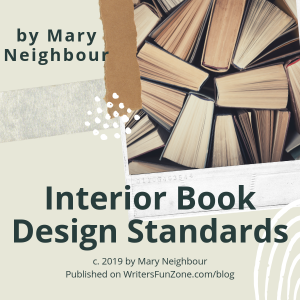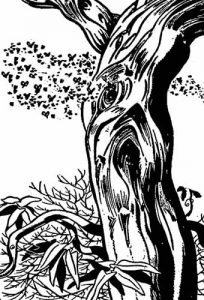How to Spot a Professional Interior Book Designer: Interior Book Design Standards by Mary Neighbour
 Please welcome back guest author Mary Neighbour as she shares with us “How to Spot a Professional Interior Book Designer: Interior Book Design Standards.” Enjoy!
Please welcome back guest author Mary Neighbour as she shares with us “How to Spot a Professional Interior Book Designer: Interior Book Design Standards.” Enjoy!
***
To a limited degree, each of us who has typed words on a page can be called a typesetter: that is, a person who places text on paper or on a computer screen to be read by others.
As an author, you likely have also chosen the arrangement of sentences and paragraphs, and you probably have bolded or italicized words for emphasis. But when you bring your manuscript to a professional typographer, that person is an artist who will style the way everything appears on the printed page, and they will possess the education and expertise to do so.
Every character, every subhead, every paragraph, every image or squiggle—even the blank space—is an aspect of interior book design.
It’s a veritable swarm of bees, and each bee has a job to do and a function to fulfill. To avoid getting stung, respect these bees!
Such magnitude of detail presents challenges, because a typographer must be knowledgeable as well as be able to give every item the focus it deserves.
Happily, the upside of having so much to juggle is that it also offers opportunities for variety and creativity, which explains why these professionals are also called interior book designers or page layout artists.
Moreover, they will design a consistent and comprehensive look for all the interior pages, so that each element participates cohesively in the composition.
Note: Layout differ from design in that the former refers to the execution of the design (often called formatting.) You may not find a professional capable of fulfilling both functions, but for the purposes of this blog, I am combining them.
In our last blog, we covered some of the terminology of a professional typographer.
Review that list to get an inkling of how extensive an interior book designer’s knowledge is.
In addition, they require creativity and keen attention to detail, so that what the page communicates matches the author’s intentions and the reader’s expectations.
To do all this successfully, they need to work within the parameters of the publishing industry and the genre of your book.
Publishing industry conventions deserve serious consideration, because to flout them is to brand your book as unprofessional. You won’t get thrown in jail for breaking the rules, but your book will be condemned to hard labor for life: obtaining quality reviews, attracting readers, getting into bookstores and libraries, or winning awards will all be unlikely.
So, what are these standards and conventions?
Here are five of the basics:
Interior Book Design Standard #1
Professional interior book design rests on a foundation of readability and comprehension.
Two ways a designer meets this standard are:
(a) understanding what the book intends to communicate and
(b) establishing a visual hierarchy.
Tip: Ask your professional to provide a sample layout of a chapter from your book.
-
- Is it easy for you to navigate?
- Do the paragraphs and other lines of text (or images) have the impact that you desire?
- Do these sample pages convey the look and feel of other books in your genre?
Such a sample will also serve as a predictor any differences in page count between your manuscript and the finished book.
Interior Book Design Standard #2
Interior design should be transparent; that is, it aids the process of reading and doesn’t distract from it.
Interior Book Design Standard #3
The design accommodates trim size, text block dimensions, number of pages, and margins, all within guidelines for the book’s genre.
Recommended: Self-published authors often worry about the number of pages, because their costs go up with each printed page. However, avoid the mistake of increasing the density of a page just to lower the page count. Be generous with “white space.”
Interior Book Design Standard #4
The treatment of spacing issues conforms to predetermined values.
These values can vary from design to design (represented below as text between brackets), but they should be calculated before layout begins.
For example:
- spacing between words is no more than the width of [a lower-case “n”] and no less than the width of [a lower-case “i”]
- a [single] blank space follows a period
- for a page containing thirty-five to forty lines, no more than [eight] hyphens are permitted
- at least [two] lines of text appear above and below a separate text element, like subheadings, an extract, or a list
- facing pages of text are of equal depth and aligned horizontally, so the leading of lines needs careful determination
- “carding” (adding extra space between lines of text to achieve facing-page alignment) is not allowed
- the last page of a chapter must contain a minimum of [five] lines
Interior Book Design Standard #5
The application of design elements is consistent and global throughout the book.
 While the above five basics will not make you an expert on typography—that takes years of study and experience—you should now be able to make an informed assessment about the quality of the design you are given.
While the above five basics will not make you an expert on typography—that takes years of study and experience—you should now be able to make an informed assessment about the quality of the design you are given.
In regards to interior design (as with all other book aspects), it bears repeating that your book should compare favorably to others in your genre.
You probably have several shelves full of titles in the same genre as yours. Make a list of the design elements that appeal to you, and share this list with your designer.
Easy, online comparisons can be made by viewing the templates at Book Design Templates and similar websites.
 Not Recommended: While it may be tempting to save money by buying an online template—instead of hiring a freelance professional—I advise against this practice. No amount of automation can deliver the top-notch results of a skilled, experienced layout artist who can tend that swarm of bees.
Not Recommended: While it may be tempting to save money by buying an online template—instead of hiring a freelance professional—I advise against this practice. No amount of automation can deliver the top-notch results of a skilled, experienced layout artist who can tend that swarm of bees.
Next week in this series: “Telltale Signs Your Layout Artist Is a Professional.”
The following week: “Questions to Ask before Hiring Your Interior Book Designer.”
***
ABOUT THE AUTHOR
 Some call Mary E. Neighbour a “book shepherd,” though Mary wields a blue pencil far more expertly than a herding rod. For the past ten years, she and her husband have helped dozens of writers bring their manuscripts to the marketplace, through MediaNeighbours, their publishing services business.
Some call Mary E. Neighbour a “book shepherd,” though Mary wields a blue pencil far more expertly than a herding rod. For the past ten years, she and her husband have helped dozens of writers bring their manuscripts to the marketplace, through MediaNeighbours, their publishing services business.
Passionate about helping authors make their work shine in the world, with a combined professional expertise of over 50 years in editing and design, this family team is one you’ll want to adopt as your guide through the challenging world of independent publishing.
Mary’s other passion is learning about the history of slavery and how it impacts race relations today. She incorporated much of her research into her novel, Speak Right On: Conjuring the Slave Narrative of Dred Scott



